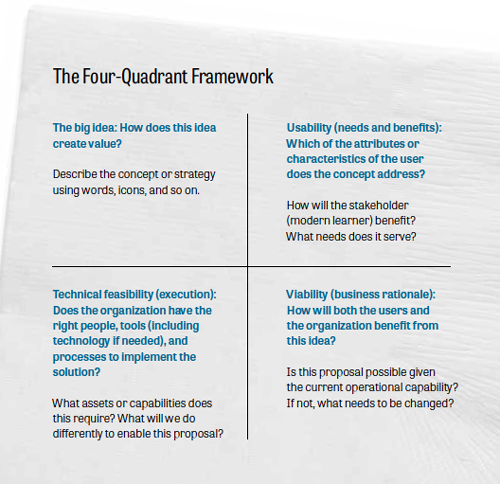TD Magazine Article
The Big Pitch
Have a new concept to present? First, grab a napkin.
Sat Jul 01 2017

Talent development professionals are constantly being asked to solve problems. Some are small; others are more complex. There are two typical starting points when faced with a problem. The first, and most natural, is to gather a group of colleagues around an easel or on Skype and start brainstorming possible solutions. A second is to conduct an Internet search to find out what the best or next practices are.
However, while those are typical strategies, neither is good for most problems that are complex, such as modernizing the learning strategy. A better starting position is to look at the current reality, the "what is." Once data have been gathered, organized, and analyzed, the problem might look different and need to be reframed—or it could become a different problem altogether. Jumping into solving a problem can result in a great solution, or a solution for the wrong problem.
There are numerous frameworks to use to solve conundrums in innovative ways, such as the traditional Shewhart process that W. Edwards Deming adapted into the Plan-Do-Study-Act cycle of improvement; LUMA's Look-Understand-Make model; Vijay Kumar's framework that involves sensing intent, knowing context, knowing people, framing insights, exploring concepts, framing solutions, and realizing offerings; and Darden's model that asks What is? What if? What wows? and What works? Within each of those frameworks are many methods, tools, and techniques—with some having built-in redundancy that requires looking at the same data from several different perspectives using multiple methods or tools.
The napkin pitch
The napkin pitch is a design thinking method espoused by Jeanne Liedtka and colleagues at the Darden School of Business. It incorporates ideas from the problem-solving repertoire of design thinking and marries it with the simplicity of Dan Roam's ideas from his book, Back of the Napkin. The napkin is an ever-present staple where people gather—on planes and trains, and in restaurants and snack shacks, for example. Generally, napkins are small, so the space is limited and forces a focus on the critical few. And the informality of it encourages drawing pictures and visuals.
Using the napkin pitch is part of the What if? section for a project. It is a method used to show an idea or concept to others after the ideas in the brainstorming have been turned into concepts. It follows after research has been completed, insights have been identified, and the design criteria have been established in the first or What is? stage of the project.
The napkin pitch uses a four-quadrant framework for communicating a concise summary of an idea or concept:
The big idea: Icons, words, bullets, and even sentences to describe a summary of the big idea solution you are recommending. It answers the question: How does this idea create value?
User desirability: This section documents how the big idea meets the needs of or benefits the user or customer. It describes how the solution seems to address a critical or unmet need of the user. It answers the question: Which of the attributes or characteristics of the user does the concept address?
Technical feasibility: This section is a description of the operational abilities and challenges involved in implementing the concept. The technical feasibility lays out steps for how this big idea can be implemented. While it may address technologies needed, the use of the term "technical feasibility" is not just technology. It answers the question: Does the organization have the right people, tools (including technology if needed), and processes to implement the solution?
Business viability: This section describes how addressing this need will result in a net positive outcome for the organization. It answers the question: How will both the users and the organization benefit from this idea?
According to Liedtka, co-author of The Designing for Growth Field Book: A Step-by-Step Project Guide, teams should develop several napkin pitches, at least three, prior to moving forward with a proposed change. One of the goals for the pitches is to obtain feedback and to respond to questions from those not involved in creating the big idea. The napkin pitch is only one of multiple iterations for a possible concept; it is not the solution. It provides the opportunity to look at an array of options and possibilities—and to get feedback prior to moving forward.
Besides capturing the What if? concepts, the napkin pitch engages everyone in further conversations. It enables others to easily share What if concepts and How might we … ideas.
Example in practice: Large group from a variety of organizations
Client: 55 senior talent development professionals
Industry: More than 30 companies, including international, private, and public
Goal: Synthesize ideas presented on modern learning and, as a group of six, develop a pitch for one idea that included visuals
Background: While this tool is typical for an intact work team, it also can be effective with a group of talent development professionals from a variety of organizations. Prior to the napkin pitch activity, the group needs to work on the What is? and some of the What if? stages of the issue. Recently at an ATD Forum lab, this method was used with 55 senior talent development professionals to examine options for modernizing learning.
One of the complex problems the industry faces is to make content and delivery approaches more learner-centered to meet the needs of the workers and the demands of the work. Much of this effort is falling under the umbrella called "the modern learner" and is about modernizing the learning strategy.
Prior to the napkin pitch activity, the participants had the opportunity to engage in or use a variety of tools and techniques to understand the What is? component of modern learning. The activities included:
an interactive panel discussion with four thought leaders on the topic
a list of references for learning more details
a keynote address by Dani Johnson of Bersin by Deloitte
developing a persona for a modern learner
benchmarking a modern learning practice
conducting self-guided research on the specific topic associated with modern learning, such as chunked content, including microlearning; experiential learning, including action learning and simulations; on-demand learning, including 24/7 access for pull learning; personalized learning; collaborative or social learning; and multimedia learning.
Process: Each of the 11 groups then worked to take one nugget or idea that was most relevant to group members and developed a pitch to present as an option for modernizing a learning strategy—albeit on a large poster sheet not on a napkin. Each group walked through each of the four steps in a nonlinear and iterative way.
Results: One group decided to design a pitch for focusing on social learning. The group's big idea was creating communities of interest that are accessible and have the capability for being autonomous, experiential, and hyperlinked. The usability quadrant included a list of needs that can be met, such as a safe and trusted place to share, where people can learn together. The technical feasibility includes a private and secure platform such as Double Dutch and a tutorial for using the platform. The business viability was increased engagement, productivity, and more efficient knowledge sharing.
Although these pitches were not presented to a panel for critique and feedback, several groups committed to taking the pitches back into their organization to their team to get feedback.
Example in practice: Individual project
Client: Doctoral student
Industry: Private university
Goal: Sort through an array of options related to a doctoral project to change the onboarding process for new administrators (both new hires and those recently promoted), present them to an audience for further feedback, and after incorporating that feedback, design a project for rigorous doctoral committee approval. The student was motivated by a quote from Google's Alberto Savoia: "Build the right IT before you build IT right." As part of her design she used a variant of the napkin pitch process focusing on the idea, the desirability for the users, the technical feasibility, and the business viability.
Background: A doctoral project or dissertation takes a huge amount of resources, especially time. In most programs the student designs the process and presents to a small committee for discussion, feedback, and approval. When all the parameters of the process have been approved, the committee provides signatory authority to proceed. A big challenge is to ensure that the process fits the needs of the student, the criteria for the project, and the committee so that when it is completed there is no rework.
Process: Prior to the project design defense, the student:
documented the steps of the current situation
conducted a literature review
benchmarked current practices in other school districts
used the force field analysis tool to determine the drivers and restrainers
analyzed the retraining forces using further research
continued to sort and sift through ideas using design thinking methods such as the Rose-Bud-Thorn, 5 Whys, empathy maps, persona profiles, user stories, assumption testing, and a Chili Table (similar to a creative matrix), with all of the options for the various components listed.
The napkin pitches included the best options. Several were presented in a discussion forum to a selection of users comprising administrators who had onboarded within the past two years and several assistant superintendents. The pros and cons of each pitch were debated.
Results: The student used the feedback to draft the final project proposal for the doctoral committee. Additionally, she used a storyboard to provide an audit trail for her research.
Go pitch
The napkin pitch is a simple format for communicating a new idea as well as the business case to support its adoption. It covers the critical components associated with the idea—the stakeholders, the ability to execute or deliver the idea, and the business rationale.
The napkin pitch is low-tech and easily replicable. As a process it can be used organizationally to standardize presenting new ideas, used by teams for feedback, and used with individual projects for discussions.
There also are a variety of ways to physically do it. For co-located groups, a hand-drawn poster chart works; for virtual teams, a shared Word or PowerPoint file can be used; and for individuals traveling, the napkin on a plane or at a restaurant works. It is easy to draw the quad chart—and there is no pressure to be an artist. The bottom line is: It works and is fun.
[

Have a new concept to present? First, grab a napkin.
](http://files.astd.org/TD-Article-Images/2017/07/HallSB-L.png)
